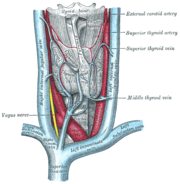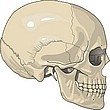Thyroid
|
|
In anatomy, the thyroid IPA: is an endocrine gland. It is situated on the front side of the neck at the level of C5 and T1 vertebral bodies, just below the Adam's apple, near the thyroid cartilage over the trachea but covered by layers of skin and muscle. The thyroid is quite large for an endocrine gland - 15-30 grams in adults- and butterfly-shaped: the wings correspond to the lobes and the body to the isthmus of the thyroid. Normally it is larger during menstruation and in pregnant women.
The primary function of the thyroid is production of hormones:
- thyroxine (T4)
- triiodothyronine (T3)
- and calcitonin, which regulates calcium-phosphorus metabolism
The production of these hormones is regulated by thyroid-stimulating hormone (TSH), released by the pituitary.
| Contents |
Histology of the thyroid
The gland is composed of spherical follicles that selectively absorb iodine (more accurately iodide ions, I-) from the bloodstream and concentrate it for production of thyroid hormones. The follicles are made of a single layer of thyroid epithelial cells, which secrete T3 and T4. Inside the follicles is a colloid which is rich in a protein called thyroglobulin. It serves as a reservoir of materials for thyroid hormone production and, to a lesser extent, a reservoir of the hormones themselves. The spaces between the thyroid follicle spheres are filled with the other type of thyroid cells, parafollicular cells or C cells, which secrete calcitonin.
Causes of thyroid problems
In areas of the world where iodine - essential for the production of thyroxine - is lacking in the diet, the thyroid gland can be considerably enlarged, resulting in the swollen necks of endemic goitre.
Thyroxine is critical to the regulation of metabolism and growth, throughout the animal kingdom. Among amphibians, for example, administering a thyroid-blocking agent such as propylthiouracil can prevent tadpoles from metamorphosing into frogs; conversely, administering thyroxine will trigger metamorphosis.
In humans, children born with thyroid hormone deficiency will not grow well, and brain development can be severely impaired, in the condition referred to as cretinism. Newborn children in many developed countries are now routinely tested for thyroid hormone deficiency; this is done by analysis of a small drop of blood from the child (usually, the blood also is tested for phenylketonuria and several other metabolic diseases of genetic etiology). Children with thyroid hormone deficiency are easily treated by supplementation with synthetic thyroxine, which enables them to grow and develop normally.
Because of the thyroid's selective uptake and extreme concentration of what is actually a quite rare element, it is extremely sensitive to the effects of various radioactive isotopes of iodine produced by nuclear fission. In the event of large accidental releases of such material into the environment, the uptake of radioactive iodine by the thyroid can, in theory, be blocked by saturating the uptake mechanism with a large surplus of non-radioactive iodine, taken in the form of iodide tablets. While biological researchers making compounds labelled with iodine isotopes do this, in the wider world such preventive measures are usually not stockpiled before an accident, nor are they distributed adequately afterward - one consequence of the Chernobyl disaster was an increase in thyroid cancers in the years following the accident. [1] (http://news.bbc.co.uk/hi/english/sci/tech/newsid_1319000/1319386.stm)
Iodised salt is a very cheap and easy way of adding iodine to the diet.
Diseases of the thyroid gland
The most common diseases of the thyroid:
- Hypothyroidism
- postoperative hypothyroidism
- iatrogenic hypothyroidism
- Hashimoto's thyroiditis
- Ord's thyroiditis
- acute thyroiditis
- Hyperthyroidism
- Graves-Basedow disease
- toxic thyroid nodule
- Thyroid nodules
- Thyroid cancer
- Goitre
Diagnosis
The measurement of thyroid-stimulating hormone (TSH) levels is useful in the diagnosis of hypothyroidism (thyroid hormone deficiency), since TSH levels are often elevated before decreased levels of thyroid hormones T4 and T3 are detectable.
History
The thyroid was first identified by the anatomist Thomas Wharton (whose name is also eponymised in Wharton's duct) in 1656. Thyroid hormone (or thyroxin) was only identified in the 19th century.
Blood supply of the thyroid
The thyroid gland is supplied by two arteries. The superior thryoid artery and the inferior thyroid artery. The superior thyroid artery is the first branch of the external carotid, and supplies mostly the top half of the thyroid gland. The inferior thyroid artery is the major branch of the thyrocervical trunk, which comes off the subclavian artery.
There are three main veins that drain the thyroid. The superior, middle and inferior thyroid veins.
Anatomy Clipart and Pictures
- Clip Art (https://classroomclipart.com)
- Anatomy Illustrations (https://classroomclipart.com/clipart/Illustrations/Anatomy.htm)
- Anatomy Clipart (https://classroomclipart.com/clipart/Anatomy.htm)
- Anatomy Animations (http://classroomclipart.com/cgi-bin/kids/imageFolio.cgi?direct=Animations/Anatomy)
| Endocrine system | |
| Adrenal gland - Corpus luteum - Hypothalamus - Ovaries - Pancreas - Parathyroid gland - Pineal gland - Pituitary gland - Testes - Thyroid gland |


